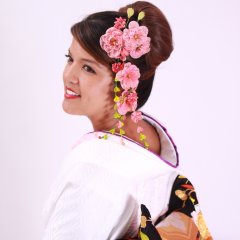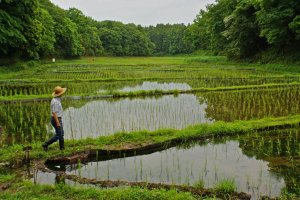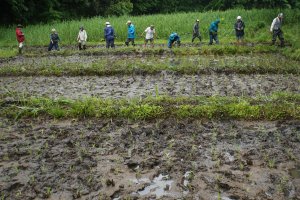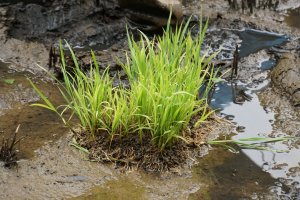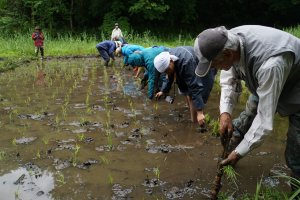Rice. The main component of meals in Asia. In Japan, “gohan” is the most common form of consumption. The “cooked rice” can be served in a bowl, a bento box, as a rice ball, or used in sushi. It can also be used to make crackers, sake, rice vinegar, and mochi. As an important grain worldwide, have you ever thought about how it is produced? Personally, after admiring views of many rice paddies throughout Japan and Philippines, I was excited to read about the opportunity to plant rice announced by Chiba City. I immediately registered and prepared to get my hands dirty!
On May 16-17th, 2015, the second stage of the Red Bull Air Race World Championship 2015 was held in Chiba City. To welcome local and foreigner fans alike, the city offered several programs throughout the week for visitors to learn about Japan. More specifically, meet Chiba City citizen expert guides and enjoy the many charms the community has to offer.
The Rice Planting activity was hosted by Mr. Hiroshi Kaneoya, owner of “’Watashi-no-inaka’” Yato Koubou” (meaning “’My home village’” Yato workshop”). He teamed up with Mr. Takanobu Yoden, the translation guide. Together they were our expert guides for rice planting at a nature-filled “Satoyama” in Yato located in the Wakaba Ward.
Mr. Kaneoya expressed the importance of “Satoyama” in his introduction to rice planting. “Satoyama” combines “sato,” meaning home or native place, and “yama,” meaning mountain or woodland. It is the traditional rural landscape that once typified most of Japan: small villages surrounded by mountains, fields of vegetation, orchards, and streams of water, coexisting with many wildlife species. A sustainable lifestyle through satoyama design and such mosaic exists right here in Chiba City!
Pants rolled up, straw hat on, and barefoot, we were transported through the nature-filled satoyama of Yato Country Hills. The beautiful, never-ending sight of greenery was a nice contrast to living in the concrete jungle. The area consists of 36 families with a long history that dates back to 6,000 years! Mr. Kaneoya, a former IT professional, decided to leave his position to focus on his property and community. His family history in Yato dates back to 1,100 years.
The growth cycle of rice is typically 3-6 months. Seedlings are planted in May/June and harvested in September/October. Most of the large rice fields are planted by machine and fed by an electrical water pump. But, there are still many paddies that are maintained by the traditional backbreaking methods.
Yato Satoyama Planning, a non-profit organization, continues to plant by hand. We joined their crew of ten to assist with planting into the deep layer of soft mud and murky water. It was quite the production line with no time for cringing “eww!” and “ahh!” A string marked off by red tags measuring about a foot apart kept us planters aligned with enough space for the seedlings to grow. With a patch of green in hand, my balance in check, and the synchronized sound of frogs in the air, four stalks were counted from the bunch, pulled, and then placed into the swampy space. Repeat until 300 square meters is complete!
The farmers are proud of the 100% organic growth cycle of rice; the fields they maintain are fed by a sacred natural spring, and fertilized by nature and insects. The ancient seed and strenuous labor make for what is considered to be "Modern High Class" rice and is sold on the market for more than three times the price of ordinary rice. Back at the workshop, our lunch consisted of green tea, homemade miso soup, and rice balls that came directly from the farm. Oishii! Delicious!
Today, I have a deeper appreciation when admiring the endless fields of rice paddies through my viewfinder. I have a better understanding of the phrase, “Finish every grain of rice in your bowl.” And….manicures and pedicures are so overrated!
If you are interested in having a similar experience, “Watashi-no-inaka” offers various workshops throughout the year. Typically held on Tuesdays, Mr. Kaneoya and the non-profit organization welcome all foreigners to experience life in “Satoyama.”

